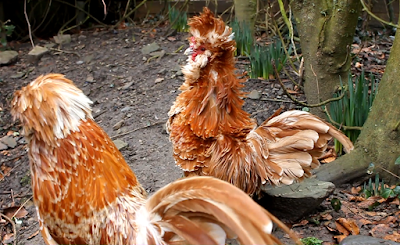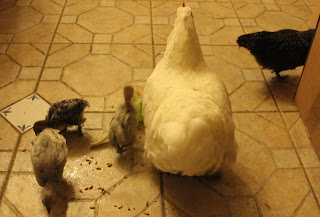In some countries, such as here in France, Frizzles are often viewed as an individual breed rather than a form of feather mutation, which can occur across several races of chicken, other poultry and wild birds. Interestingly in the 17th century, the ornithologist Carl von Linné, believing them to belong to a completely different species, catalogued them under the wonderful name of Gallus crispus! I've always been crazy about Frizzles ever since I was lucky enough to be given one to rehome many years ago. Below is Goldie, a second generation frizzle, with a mixture of Sebright x Ardenner x our Rehomed Frizzle of unknown breed. She has quite a delicate frizzling due to the Sebright and Ardenner influence, which are quite light plumaged birds. She is also sun-worshipping, so her feathers are less frizzled than usual but more of this later.
If you've ever read 'Genetics of the Fowl' by F.B Hutt, which I dip into now and again whenever I'm feeling strong enough, you will know that Frizzles were first identified in a drawing sent to the Italian naturalist Ulisse Aldrovandi, who included them in the second volume of his Ornithologiae, published in 1599.
I love the look of the Frizzle as depicted in this early drawing because to me it explains their character perfectly. They are determined, loyal and incredibly independent, something which makes both the male and female serious contenders for dominance, in a flock. It also, along with their striking appearance, makes them very easy to tame as they are often perceived as being less like domestic birds and more like fancy fowl. This is actually to do them a disservice as they are, despite appearances, incredibly hardy, rustic feeders, wonderful mothers and sometimes fathers and great for a forest garden. Although their altered wing feathers stop them from flying, they are great climbers and jumpers, so fit well into the arboreal landscape of a food forest.
In 1676 when Francis Willughby of Warwick published his Ornithologiae, he made much of the fact that the Frizzle had been erroneously named 'the Friesland' due to a bastardisation or misunderstanding of the word. He further believed this had come about because by association; 'one would be apt to attribute (frizzling) to horror of cold'. In fact if you have seen my posts on cold stress you will know I was driven to make coats for my older Frizzles, one of whom was very obvious, albeit non-verbally, in his protest about cold weather!
However, if conversely, you take a look at one of my Polish Frizzles in full Winter plumage, you realise that, in fact with the added air pockets provided by the frizzling, he is actually warmer than his smooth feathered brother. This is due to what one might call the 'eiderdown' effect. The problem and conflict of ideas arises also from the difference exhibited in the degree of frizzling, such as in those mutations known colloquially as 'woolies' and 'curlies', which can lead to their feathers being brittle and easily damaged. There is also some question about the basal metabolism of these Frizzles due to the spacing of the feathers and the paucity of the down feathers.
In 1676 when Francis Willughby of Warwick published his Ornithologiae, he made much of the fact that the Frizzle had been erroneously named 'the Friesland' due to a bastardisation or misunderstanding of the word. He further believed this had come about because by association; 'one would be apt to attribute (frizzling) to horror of cold'. In fact if you have seen my posts on cold stress you will know I was driven to make coats for my older Frizzles, one of whom was very obvious, albeit non-verbally, in his protest about cold weather!
However, if conversely, you take a look at one of my Polish Frizzles in full Winter plumage, you realise that, in fact with the added air pockets provided by the frizzling, he is actually warmer than his smooth feathered brother. This is due to what one might call the 'eiderdown' effect. The problem and conflict of ideas arises also from the difference exhibited in the degree of frizzling, such as in those mutations known colloquially as 'woolies' and 'curlies', which can lead to their feathers being brittle and easily damaged. There is also some question about the basal metabolism of these Frizzles due to the spacing of the feathers and the paucity of the down feathers.
As with everything with chickens and in fact as far as I am concerned, birds and animals in general, it is all down to individuals, something research often fails to address. My mistake was to be so quick off the mark to breed from my rehomed Frizzle, that I paired her up with my then only cockerel, a Sebright, thus giving my first frizzled chicks the problem of very fine frizzled feathers, which were both more brittle and sparser than normal. This however, only became a problem in old-age and, as I had a solution, was one we could cope with. So the argument that all Frizzles need a hot climate won't wash, in fact where could you find a warmer snugglier home than with these frizzled Mummies?
Although feathers were thought to be composed primarily of beta-keratins you have no doubt read recently that it is an alpha-keratin mutation which causes frizzling. Well genetics is, to say the least, complicated and fraught with controversy so I'm not sure how far this gets us. However, if we enlarge a section from the above image and also take a look from another angle, we can see what has happened to the structure of the feather.
So how does the frizzle mutation express itself?
Frizzling has been described by geneticists, as a distinct curl backwards, thus outwards and upwards in the rachis (shaft) of the feather. The Frizzle was also aptly described by George Louis Leclerc, Count de Buffon, as having feathers 'in a reversed position', when he included it in his Natural History of Birds, which was published in 1793.

The curling is made up of irregular kinks, which we see quite clearly
in the image above and in that of Spike, our Black-laced Gold crested and bearded Frizzle
and his Chamois father below. Where I part company with the research, is the suggestion that this curling precludes the feathers from ever lying flat against the body. This is because it is something I have witnessed 'in the field'. Again, I will expand on this later when I come to look at the psychology of frizzling. The irregular kinking or curling of the feathers is not the whole story, as Frizzles also have thickening of the barbs
and barbules and alteration of the hooklets. This explains even further why they do not fly as well as normal chickens. As an illustration of the anatomy of the feather I have taken an old cockerel (non-frizzled) feather my neighbour gave me and which, as not being in its premier jeunesse, shows up very clearly the different components. The image was obtained with the use of a supermarket purchased, mini microscope from the Science Museum!
The frizzling mutation usually comes out at 50% of the chicks hatched from a Frizzle matched with a non-frizzle. Bungle, the mother, is possibly latent Frizzle as she comes from the same breeder. I got the eggs for her and Diavolo (the father) off e-bay, only four hatched from the dozen but they have all grown into wonderful creatures, hardy and rustic (see below) whether frizzled or not. If you are living in a very cold climate and want Frizzles, then Polish or Cochin or any of the other heavier plumaged birds are probably your best choice.
In the next article I'll look at, what for me is the most interesting facet of frizzling. This being, the psychological aspect of having frizzled feathers. It is this that impacts most upon the forest garden environment and why I believe a Frizzle (or several) in you flock is a fine choice and a fabulous edition.
Meanwhile
all the very best and if you have enjoyed this piece and found it
interesting and/or useful please feel free to join the blog, subscribe
to my youtube channel and of course to ask questions or comment and
share your own experiences.
Sue
The original 16th century drawing of a Frizzle, thanks to the Pinterest Board of summagallicana.it
RELATED ARTICLES
 Frizzles for a Forest Garden 2 Behaviour & Emotions
Frizzles for a Forest Garden 2 Behaviour & Emotions
Spike
is a fine example of a Polish Frizzle and has also something which I
believe well illustrates the dilemma faced by the Frizzled bird...read more
Polish Crested - Beauty, Brains and Rusticity.
It's hard to believe that a creature which looks so frou-frou can be anything but ornamental and therefore totally unsuited to a backyard or smallholding but in the following article...read more
 Practical Prevention & Cure - Cold Stress
Practical Prevention & Cure - Cold Stress
Although
this might seem to be some chichi fashion statement, the idea of
creating a coat for your chicken, matching or not, is deadly serious... read more
RETURN TO CONTENTS PAGE
© 2016 Sue Cross





















